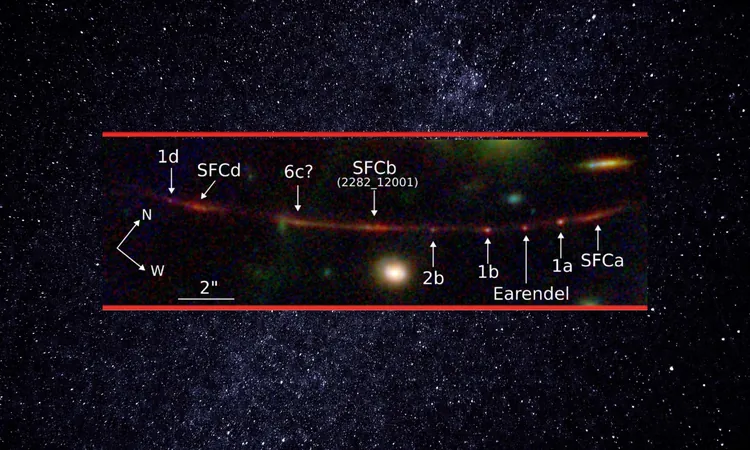
Incredible Discovery: Earendel - Distant Star or Cosmic Cluster?
2025-08-31
Author: Yu
Meet Earendel: The Universe's Most Distant Star
Prepare to be amazed! The newly identified star, dubbed Earendel, sets the record as the most distant known star, sitting a staggering 12.9 billion light-years away. This brilliant beacon of light first began its journey before the Universe was even a billion years old!
A Cosmic Twist in the Tale!
But hold on—new revelations from the state-of-the-art James Webb Space Telescope (JWST) suggest that Earendel might not be a solitary star at all. Instead, it could be part of a tight-knit group of stars held together by gravitational forces!
If this turns out to be true, it could revolutionize our understanding of how astronomers utilize cosmic alignments to explore the fledgling Universe and could provide crucial insights into the formation of today's ancient star clusters.
Unveiling the Mystery of Earendel
Massimo Pascale, lead researcher from the University of California, Berkeley, highlights that the original detection made by Hubble hinted at multiple possibilities. Recent studies proposed a redshift of 6.2, taking us back to about 900 million years post-Big Bang, but this highly magnified light could conceal a multitude of stars.
Earendel’s light travels through a galaxy cluster, serving as a massive cosmic lens that amplifies light through gravitational lensing. Recent JWST analyses have boosted the magnification estimate to over 4,000, transforming an otherwise minuscule source into a brilliant point of interest.
What JWST Discovered!
Using JWST's NIRSpec prism, the team unraveled Earendel's spectrum, revealing how brightness fluctuates across near-infrared wavelengths. By comparing the data with models of compact clusters, the findings indicated a strong alignment with the cluster hypothesis.
"If Earendel truly is a star cluster, it’s not a shocking twist!" reports Pascale. The spectral analysis, particularly at NIRSpec’s resolution, shows that distinguishing between a single star and a star cluster can be deceptively tricky.
The Quest for Clarity: Stars vs. Clusters
The investigation continues! Astronomers utilize a phenomenon called microlensing, where temporary brightening occurs when smaller masses obscure the light from a distant source. Statistically, a single star displays sharper fluctuations compared to a larger cluster, so continuous monitoring could provide clarity.
Furthermore, JWST’s ability to detect unique spectral features may reveal if a massive dominant star is present. If absent, and the light corresponds to a mix of low-metallicity stars, the evidence for a cluster grows stronger.
Earendel: A Glimpse into Cosmic History
If Earendel is indeed a compact cluster, it could serve as a direct ancestor to the dense globular clusters observable in nearby galaxies today. Such modeling hints at low heavy element content and intermediate ages, characteristics that echo early cluster formation.
This scenario offers a rare opportunity to study star formation amid the harsh conditions of the cosmic dawn, suggesting that star clusters were already coalescing in the young Universe.
The Importance of Cosmic Alignments
Astounding cosmic alignments like the one showcasing Earendel are more than mere coincidences; they allow astronomers to peer into the deepest, faintest corners of our Universe, revealing new galaxies, clusters, and individual stars that are crucial for testing theories of early structure formation.
What’s Next for Earendel?
The journey continues for astronomers as they monitor Earendel's brightness for signs of microlensing. If the light remains steady instead of fluctuating wildly, this will lend credence to the cluster theory.
With plans for higher-resolution spectra to detect faint absorption features, scientists aim to dissect this cosmic enigma further. As research progresses, Earendel may transition from an intriguing nickname to a thoroughly understood cosmic object.
This groundbreaking study is featured in The Astrophysical Journal Letters— a testament to the relentless pursuit of knowledge in our ever-expanding Universe!



 Brasil (PT)
Brasil (PT)
 Canada (EN)
Canada (EN)
 Chile (ES)
Chile (ES)
 Česko (CS)
Česko (CS)
 대한민국 (KO)
대한민국 (KO)
 España (ES)
España (ES)
 France (FR)
France (FR)
 Hong Kong (EN)
Hong Kong (EN)
 Italia (IT)
Italia (IT)
 日本 (JA)
日本 (JA)
 Magyarország (HU)
Magyarország (HU)
 Norge (NO)
Norge (NO)
 Polska (PL)
Polska (PL)
 Schweiz (DE)
Schweiz (DE)
 Singapore (EN)
Singapore (EN)
 Sverige (SV)
Sverige (SV)
 Suomi (FI)
Suomi (FI)
 Türkiye (TR)
Türkiye (TR)
 الإمارات العربية المتحدة (AR)
الإمارات العربية المتحدة (AR)